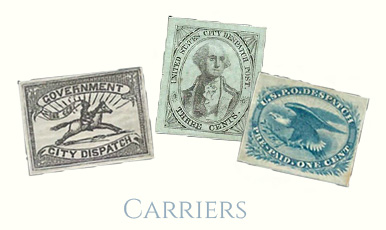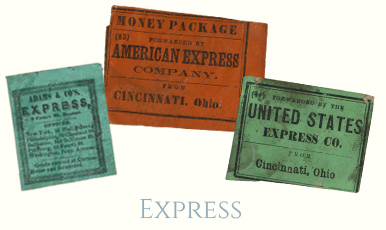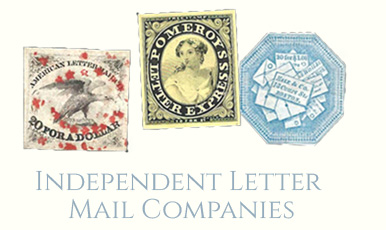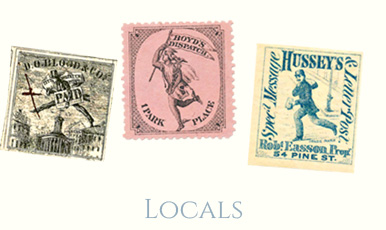Exhibits and Presentations
Carriers
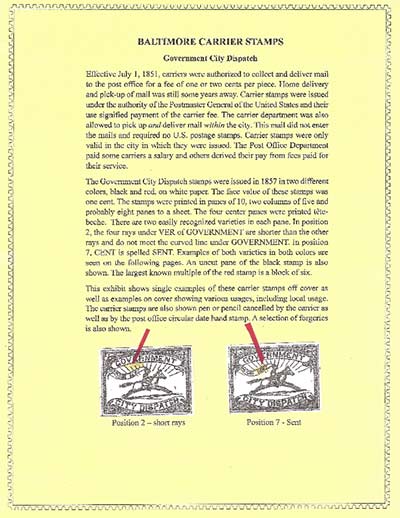
Baltimore Carrier Stamps—Government City Dispatch
By: Richard Colberg (2023)
The exhibit shows covers and stamps, including plate positions, of the Baltimore carrier office’s “Horseman Stamp.” Baltimore carriers sold the stamp for prepayment of mail collection and delivery services. It was issued in red and black and used in Baltimore from 1857 until 1860.
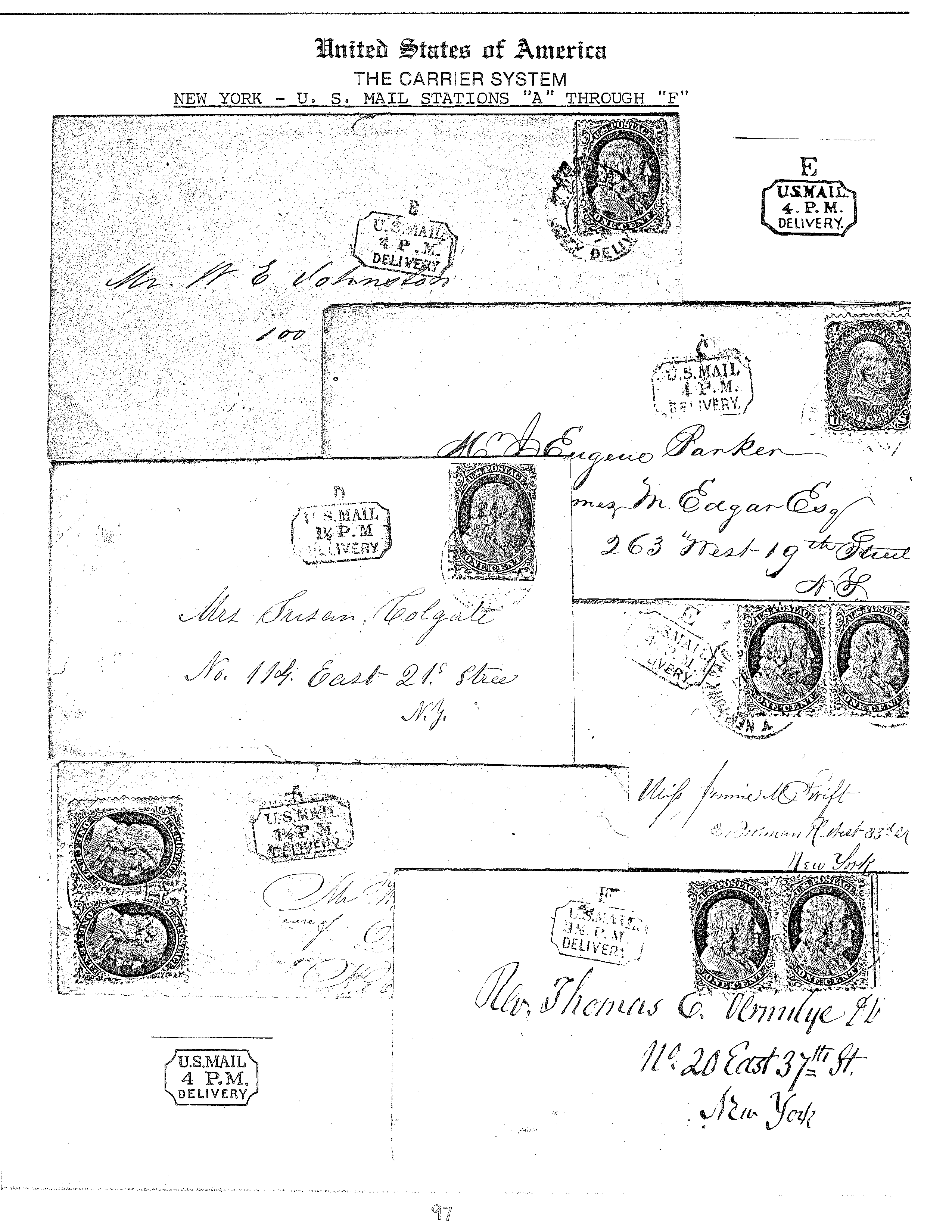
By Penny Post
By: Robert B. Meyersburg (1990)
This exhibit examines the workings of the government carrier services in a dozen post offices with carrier departments, arranged alphabetically. Several examples of private letter dispatch service and independant mail service are included for their particular contribution to the overall history.
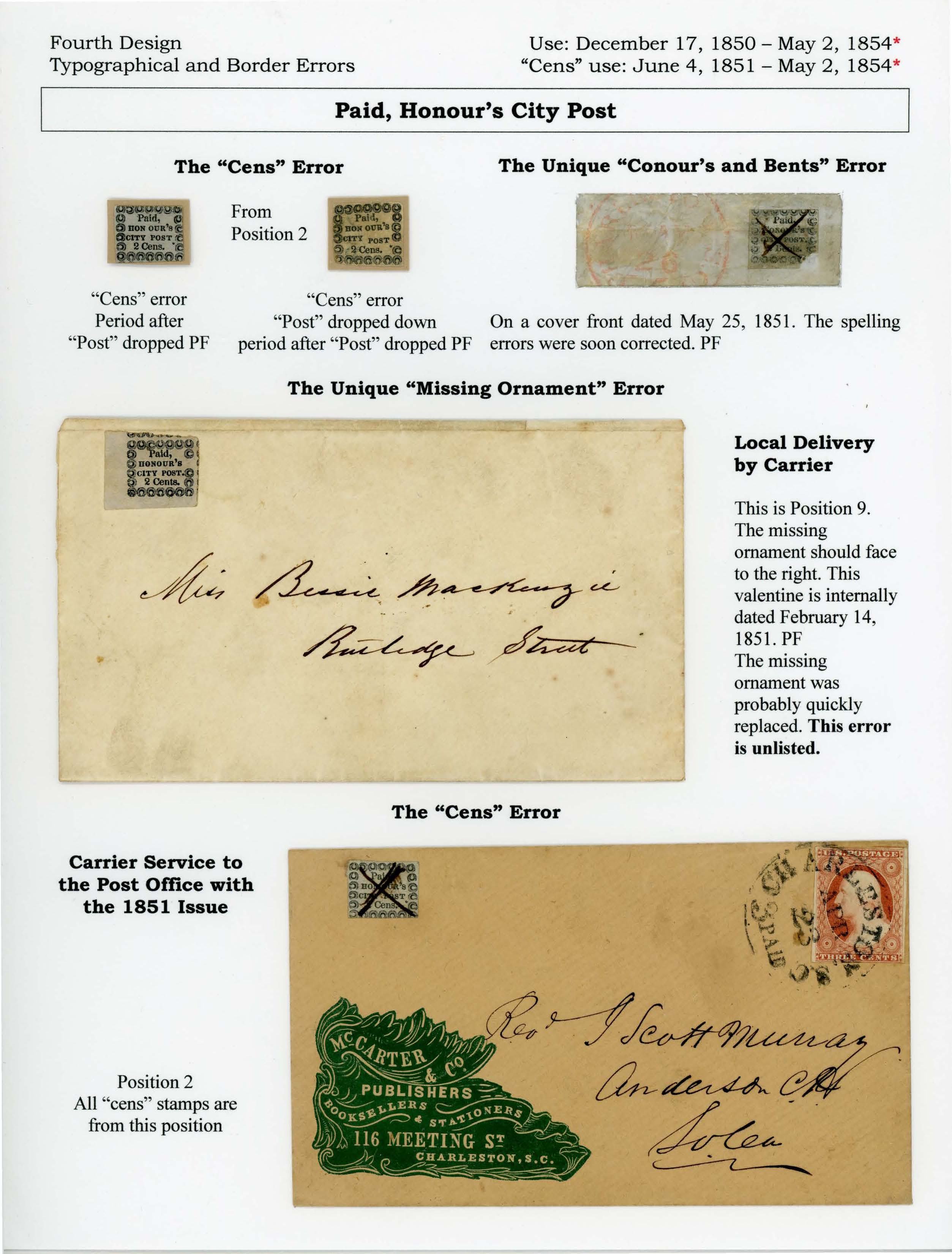
Honour's City Express Post
By: Larry Lyons
The Charleston S.C. carrier department was first announced in May, 1849. The appointed superintendent of the carrier department was Dr. John H. Honour. This exhibit shows all the adhesives issued by John Henry Honour for the Charleston Carrier Department and presents the determined order of issued based on the exhibitor's study.
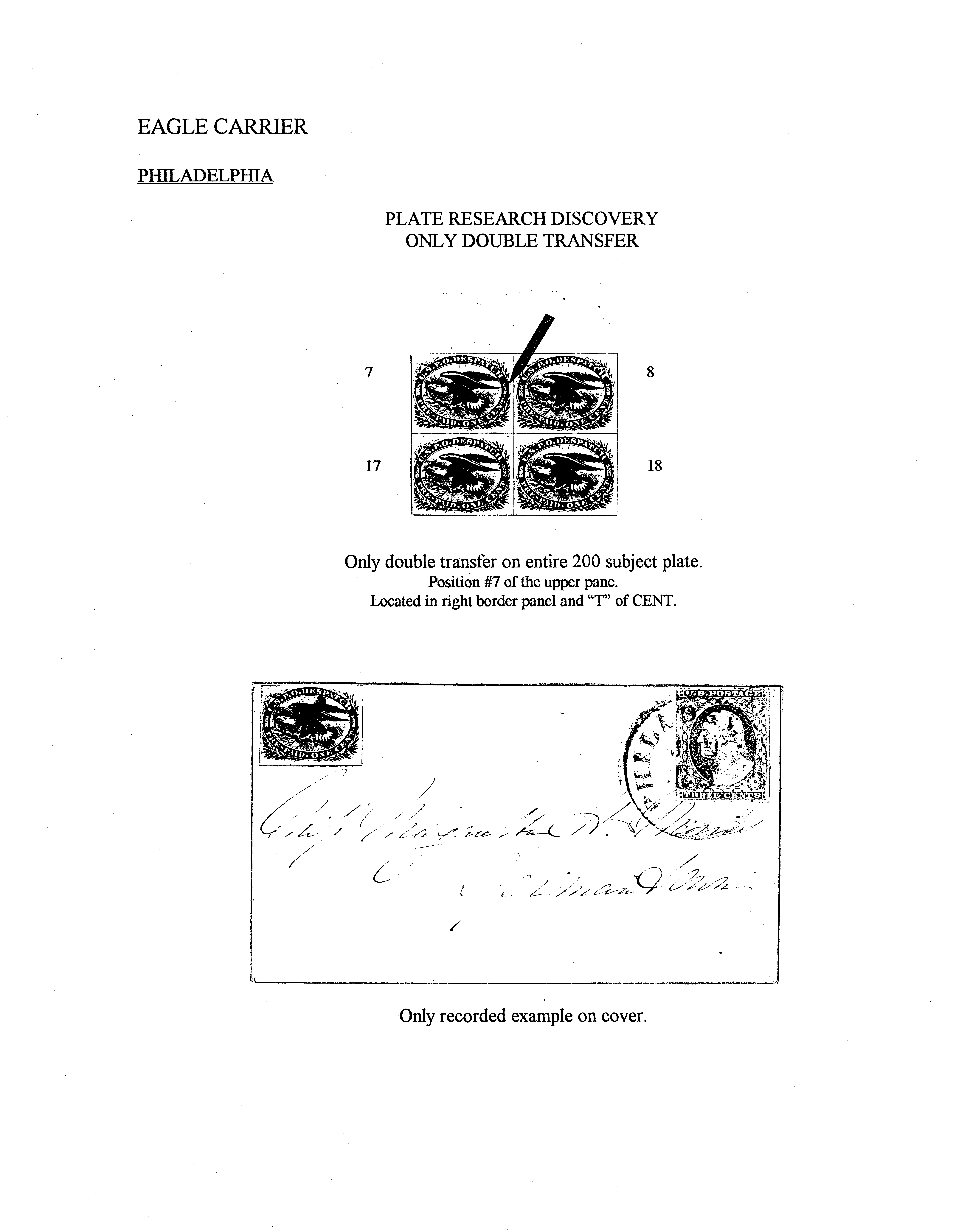
US Carrier Studies
By: Donald B. Johnstone (2003)
This exhibit begins with the official carriers, the Franklin and Eagle carrier stamps, showing their proofs, reprints, and usage by city alphabetically. This is followed by evidence of carrier service activity in cities arranged alphabetically, with use of semiofficial carrier stamps, regular postal issues to prepay carrier services, as well as the numerous and varied carrier markings employed. The major carrier cities, New York, Philadelphia, Boston, and Baltimore experienced more carrier activity than other carrier cities, and therefore provide more examples of this activity than do the other cities included here. Other cities with carrier service during tile carrier fee period shown here include Brooklyn, "Charleston, Charlestown, Cincinnati, Cleveland, Louisville, Lowell, New Orleans, Portland, and Washington.
Independent Mail Companies and Express Companies
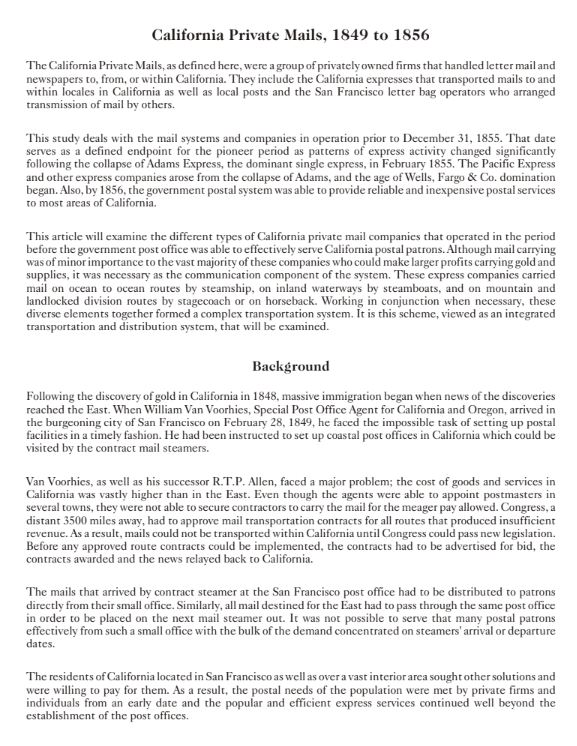
California Private Mails, 1849 to 1856
By: Richard Frajola
This exhibit examines the types of California private mail companies that transported mail and packages before the U.S. Post Office Department was able to effectively serve California postal patrons. These express companies carried mail on ocean routes by steamship, on inland waterways by steamboats, and on mountain and landlocked division routes by stagecoach or on horseback. In some cases, these companies entered into cooperative arrangements with each other to create a complex mail transportation system.
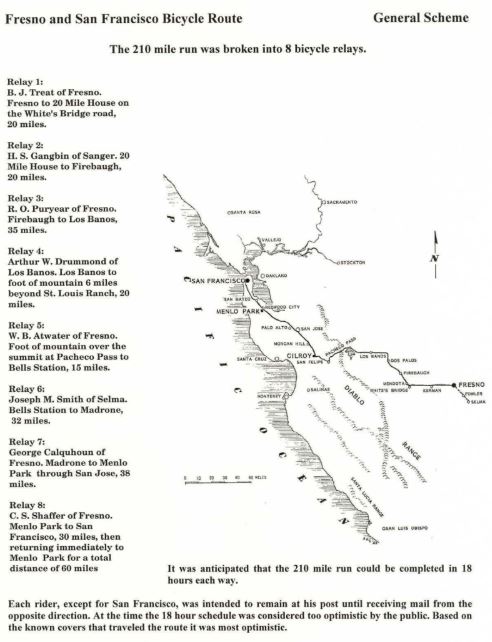
The Fresno and San Francisco Bicycle Mail of 1894
By: Leonard Hartman
This exhibit tells the story of the Fresno and San Francisco Bicycle Mail, a legitimate local service established by Arthur Banta to transport mail in northern California during a nationwide railroad strike in 1894. The Pullman strike began May 11, 1894, due to wage cuts at the Pullman Palace Car Company and spread when the American Railway Union declared a boycott of Pullman cars on June 26. The strike was violent and severely disrupted railroad operations, especially mail service west of Chicago.
The Eastern Independent Mail Companies of 1844-1845: Determined Competitors to the Post Office
By: David W. Snow
This presentation explores how a handful of private mail companies forced the Post Office Department to reduce its rates and become competitive.
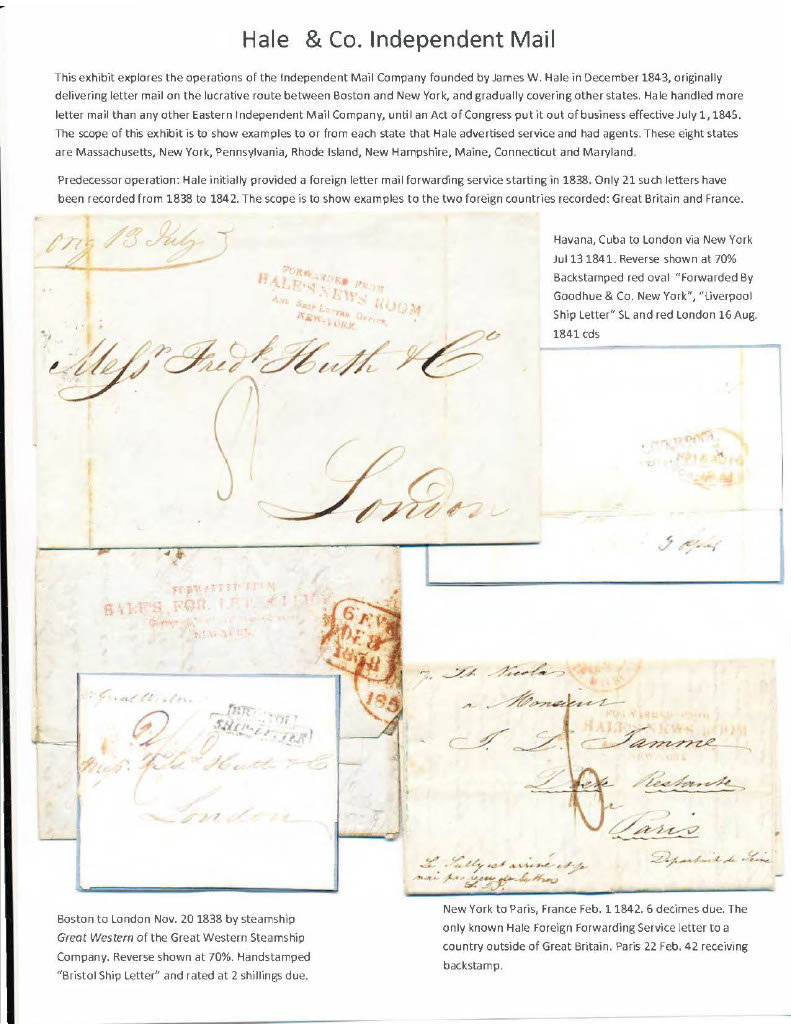
Hale & Co. Independent Mail
By: David W. Snow
This one-frame exhibit explores the operations and geographic reach of the independent mail company founded by James W. Hale in December 1843. Hale & Co. was the most successful of independent mail companies, transporting between cities more letters than any other. The exhibit includes covers for all eight eastern states in which Hale & Co. offered its services and had agents.
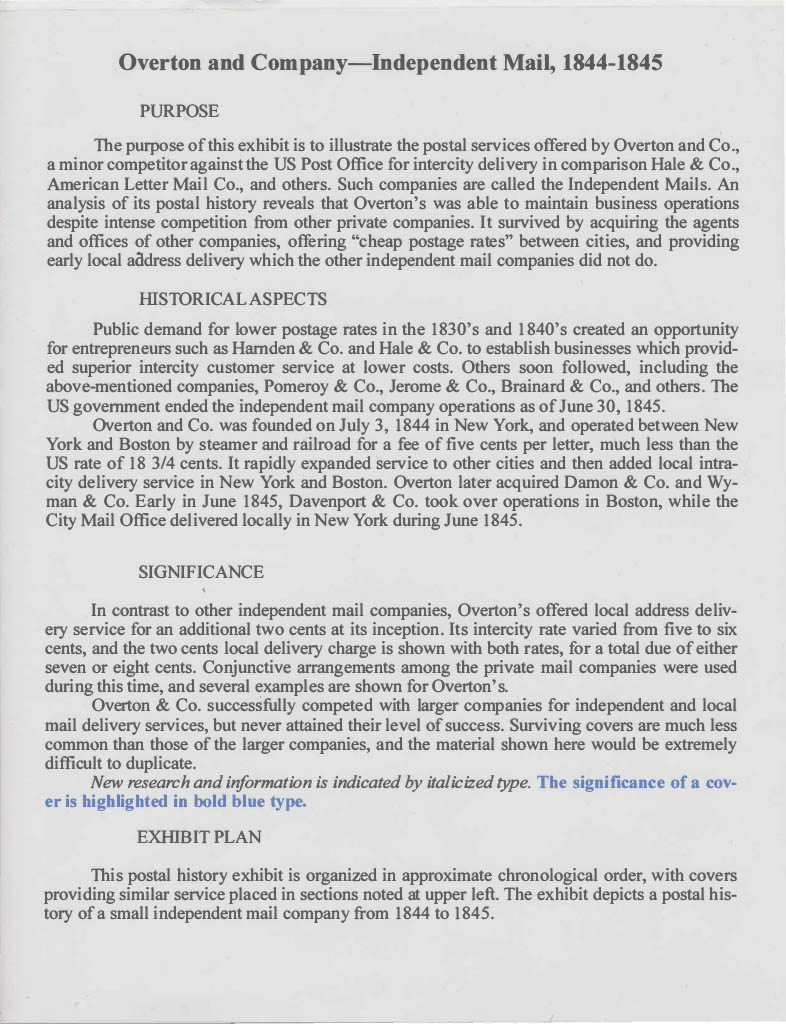
Overton and Company - Independent Mail, 1844-1845
By: John D. Bowman
This exhibit illustrates the postal services of Overton and Co., an independent mail company that transported mail by railroad and steamer for only one year, from July 1844 to June 1845, when the federal government put the independent mail companies out of business. Overton also operated a local post in New York that continued to operate after 1845.
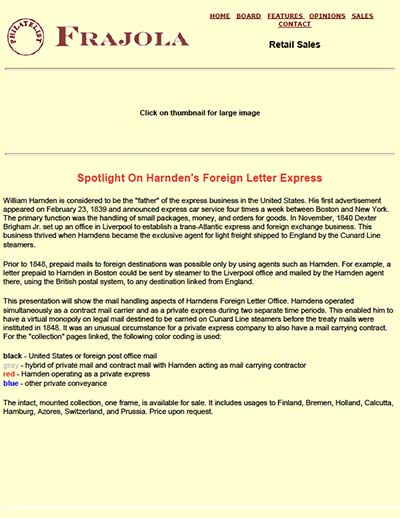
Harnden’s Foreign Letter Express
By: Richard Frajola (2005)
This one-frame exhibit shows covers carried from 1839 to 1851 between Boston and New York City by William Harden’s foreign letter offices from 1839 to 1851, when the POD began offering foreign letter mail service. Covers include examples of all the Harnden handstamps used during the twelve years. The exhibit is divided into four periods based on Harnden & Co’s business operations: (1) from 1839 to 1841, when William Harnden also served as a POD contract mail carrier between Boston and New York; (2) from 1841 to 1842, when Harnden also operated a private letter mail and package express business; (3) from 1842 to 1844, when Harnden served as a PODZ regulated contract mail agent; and, (4) from 1844 to 1845 when Harnden also operated as a private letter mail company (until June 30, 1845) and package express company.
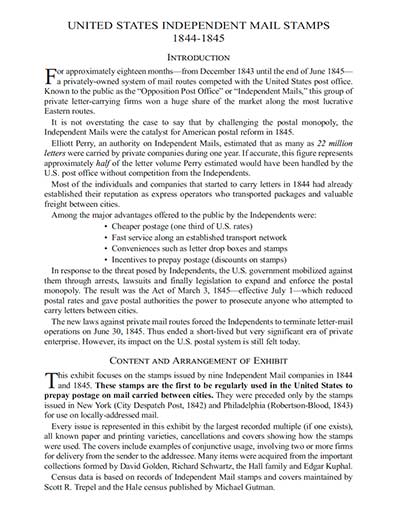
United States Independent Mail Stamps
By: Dr. Carmen Puliafito (2016)
The exhibit focuses on the stamps issued by the nine independent mail companies that provided intracity mail service from early 1844 until June 1845, when they were forced to stop by Federal legislation. Their stamps were the first used in the U.S. to prepay the rates for intra-city transportation of letters. The exhibit shows advantages the companies offered the public, including cheaper rates, faster service and discounts for purchases of full sheets of stamps.
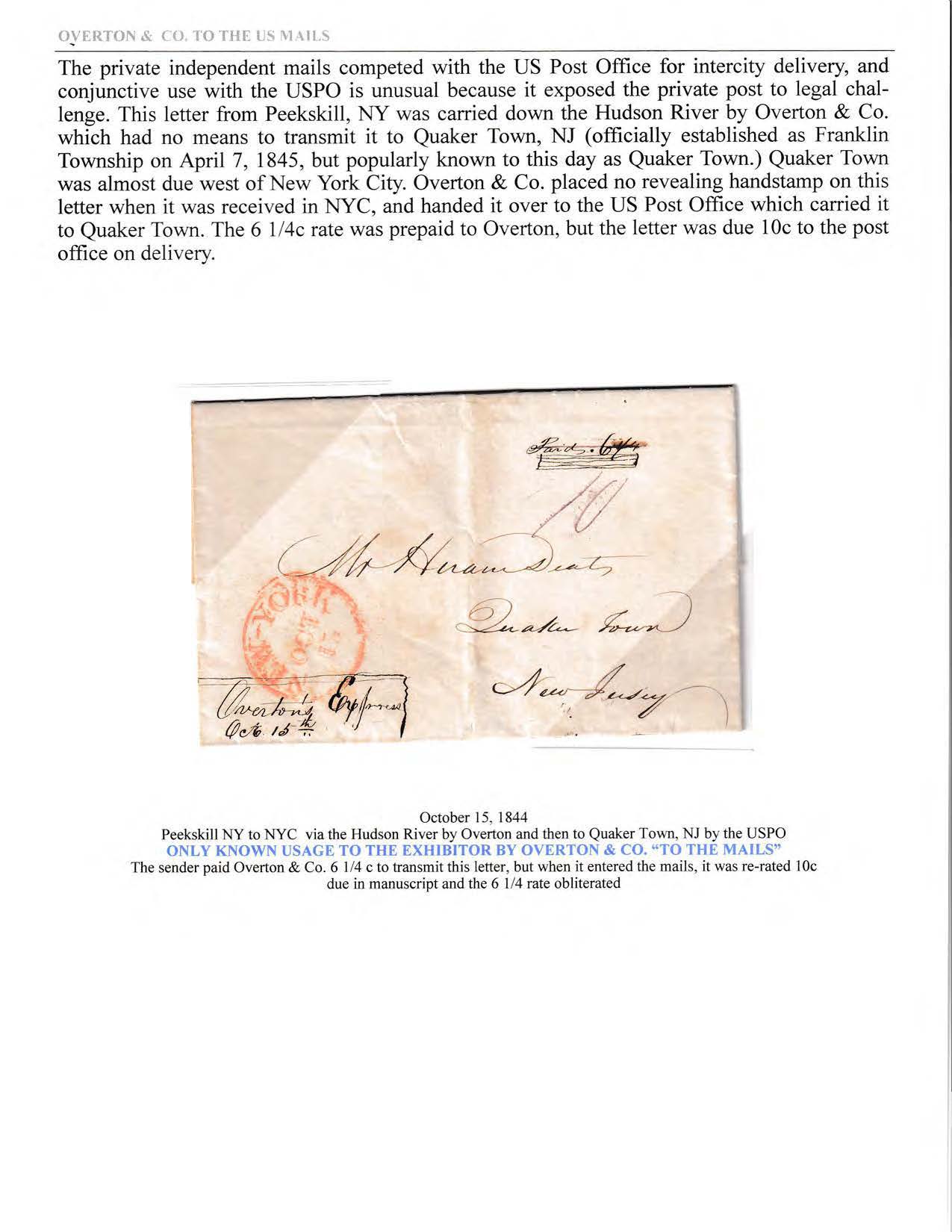
Overton and Company - Independent Mail, 1844-1845
By: John Bowman (2019)
The purpose of this exhibit is to illustrate the postal services offered by Overton and Co., a minor competitor against the US Post Office for intercity delivery in comparison to Hale & Co., American Letter Mail Co., and others. Such companies are called the Independent Mails. And analysis of its postal history reveals that Overton's was able to maintain business operations despite intense competition from other private companies. It survived by acquiring the agents and offices of other companies, offering "cheap postage rates" between cities, and providing early local address delivery which the other independent mail companies did not do.
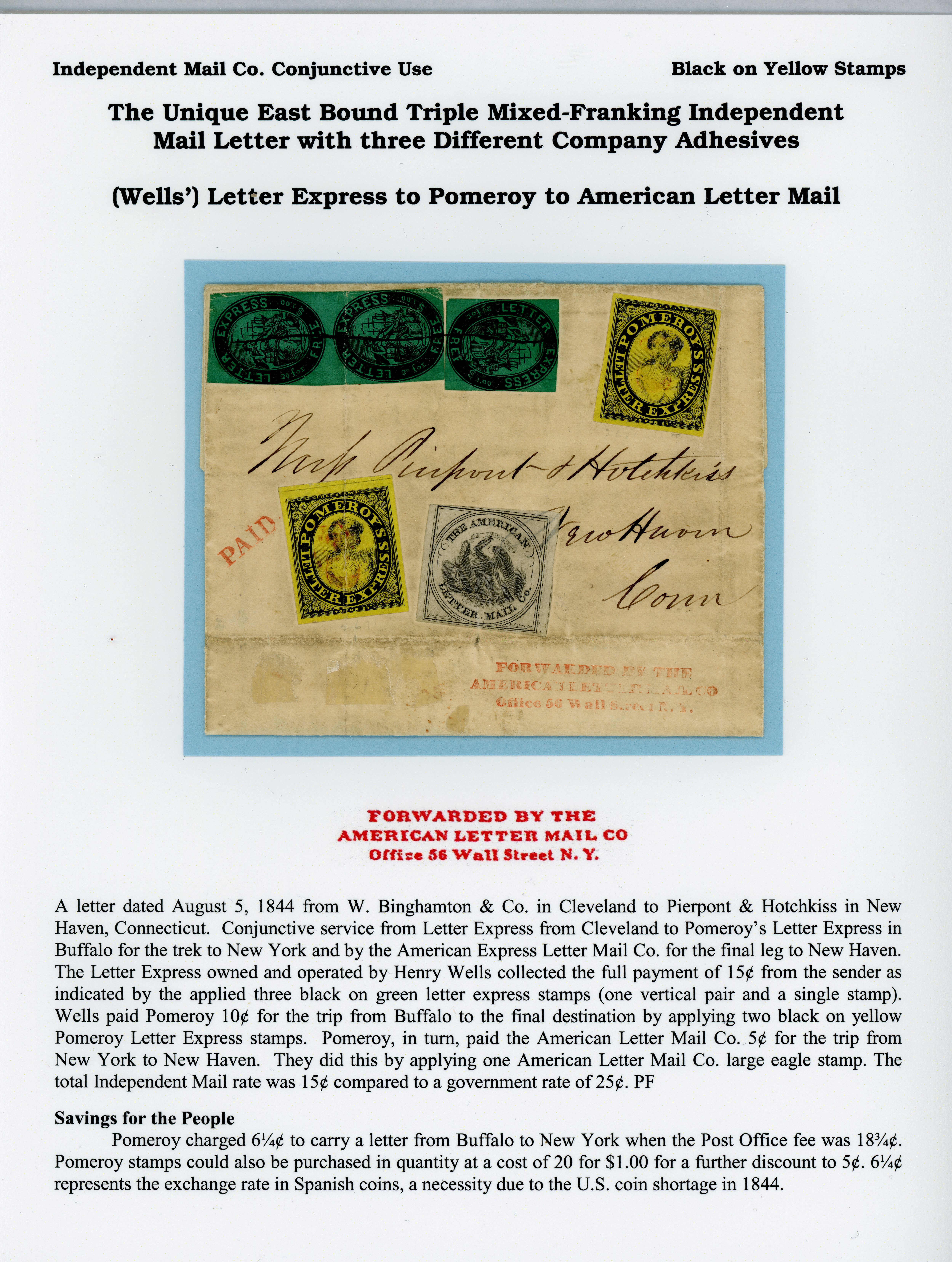
Pomeroy's Letter Express: A Tale of Deceit, Success and Shutdown
By: Larry Lyons
A single frame exhibit showing the adhesive stamps of the Pomeroy Letter Express, an Independent Mail Company, and show stampless covers indicating that Pomeroy & Co., the express package service, continued to carry letters.
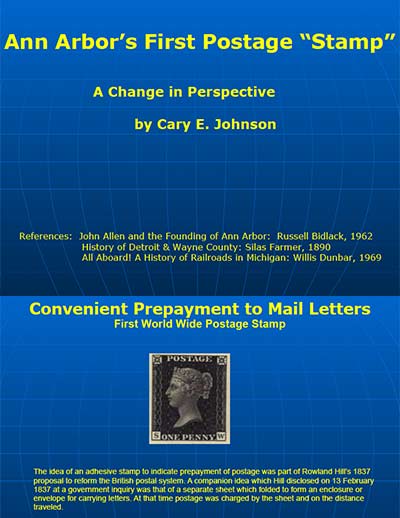
Wells & Co. Express and (Wells) Letter Express Co.--"Ann Arbor's First Postal Stamp"
By: Cary E. Johnson (2010)
After a discussion of early postal history and use of the first U.S. general issue stamps in Ann Arbor, two-thirds of the presentation is devoted to Wells & Co. Express and Henry Well’s independent mail company, the Letter Express. The presentation includes slides illustrating the labels of Wells Express and the stamps of Letter Express, as well as their routes."
Local Posts
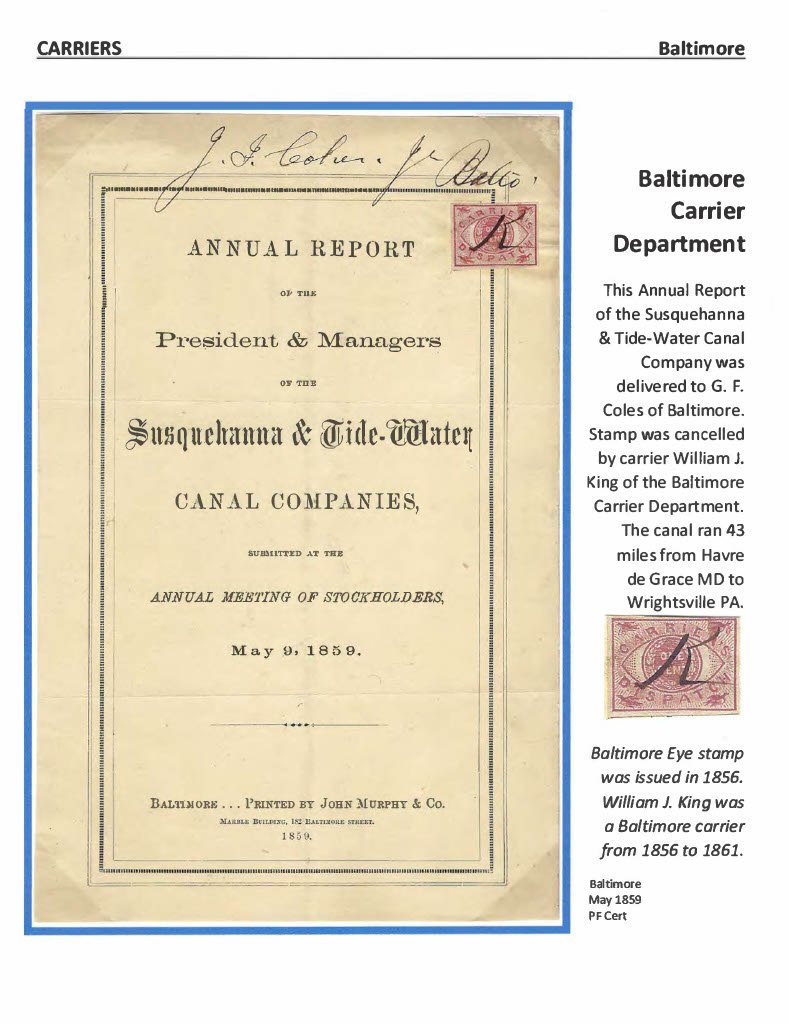
Carriers and Local Posts Delivered Diverse Magazines, Reports and Pamphlets
By: Clifford J. Alexander
This one-frame exhibit shows the range of magazines, reports, pamphlets and journals delivered in cities during the late 1840s and 1850s by local posts and carriers. Publications represented a significant part of their business, but few have survived. The exhibit shows three with a carrier stamp or handstamp and fifteen with a local post stamp or handstamp.
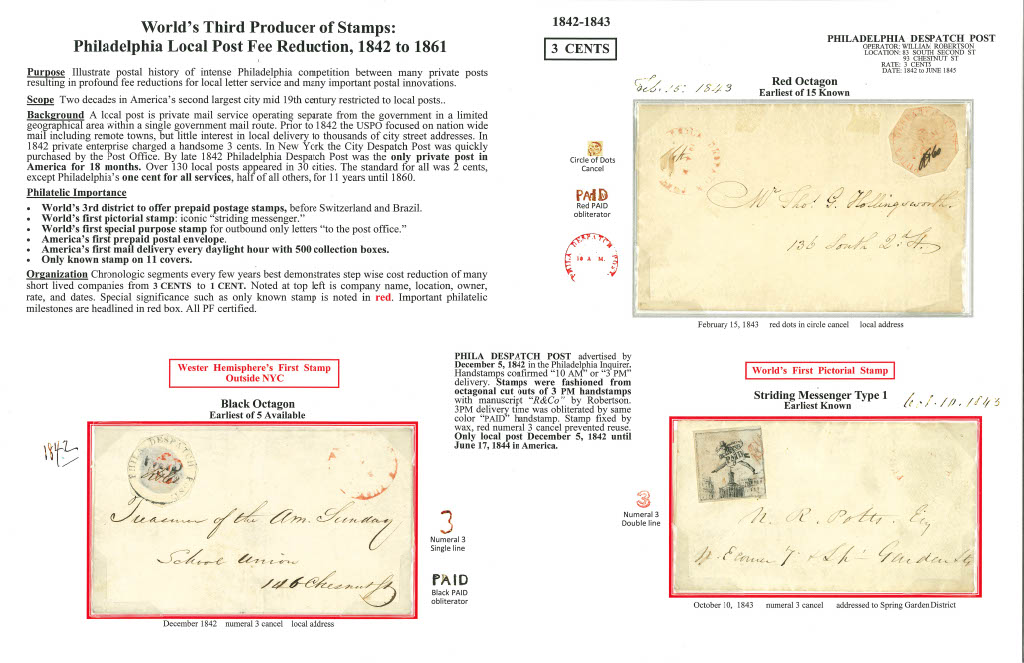
World’s Third Producer of Stamps: Philadelphia Local Post Fee Reduction, 1842 to 1861
By: Dr. Vernon Morris
Dr. Morris’ one-frame exhibit tells the postal history story of intense competition that the Philadelphia post office faced from local posts, from the establishment of the Philadelphia Despatch Post in 1842 to the closing by the federal government of Blood’s Penny Post in 1862. Covers illustrate the impact on post office operations, including reduced fees and innovations in service.
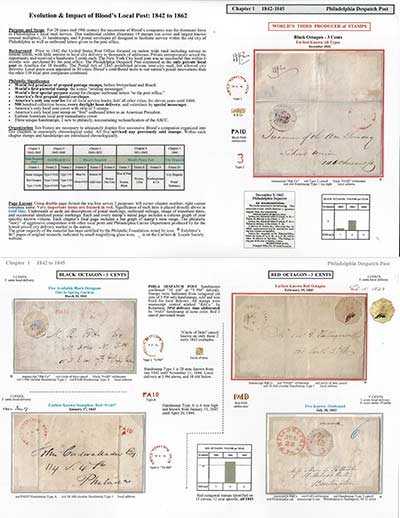
Evolution & Impact of Blood's Local Post: 1842 to 1862
Frame 1 |
Frame 2 |
Frame 3 |
Frame 4 |
Frame 5 |
Frame 6 |
Frame 7 |
Frame 8 |
Frame 9 |
Frame 10
By: Dr. Vernon Morris (2023)
This traditional exhibit displays unused stamps, proofs and essays, as well as covers for both local delivery as well as outbound letters given to the post office. Special examples include the first and last date confirmed examples, the world’s first pictorial stamp, earliest recorded, and the nations first prepaid postal envelope, earliest known. For the public's convenience, Blood's Despatch established 500 collection boxes on corners and in stores, offered hourly datetime delivery, special messengers, and volume discounts. For over 20 years, Blood’s contributed more to postal innovations than all the nation’s other 130 local post companies, plus was the model local post in Philadelphia and arguably the nation.
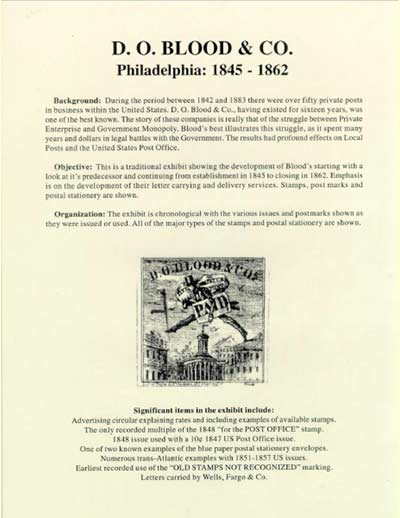
D. O. Blood & Co. Philadelphia: 1845-1862
By: Martin Richardson (2006)
The exhibits includes the postal history of the development and operation of Blood’s Despatch Post from its beginning (including its predecessor) until the post closed in 1862. Although still highly successful, Blood’s was forced to close at the end of 1860 because of actions by the federal government enforcing a law designed to eliminate competition with post office carrier service in large cities.
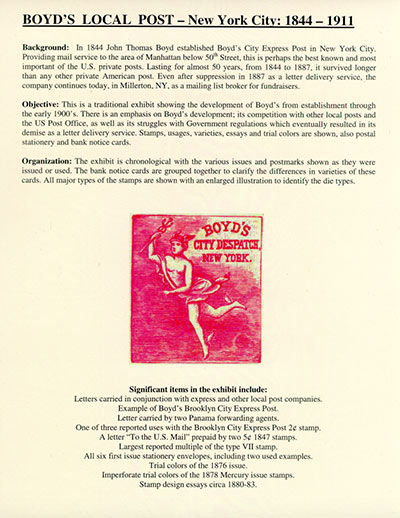
Boyd's City Express
By: Martin Richardson (2017)
This is a traditional exhibit showing the development of Boyd's from establishment through the early 1900's. There is an emphasis on Boyd's development; its competition with other local posts and the US Post Office, as well as its struggles with Government regulations which eventually resulted in its demise as a letter delivery service. Stamps, usages, varieties, essays and trial colors are shown, also postal stationery and bank notice cards.
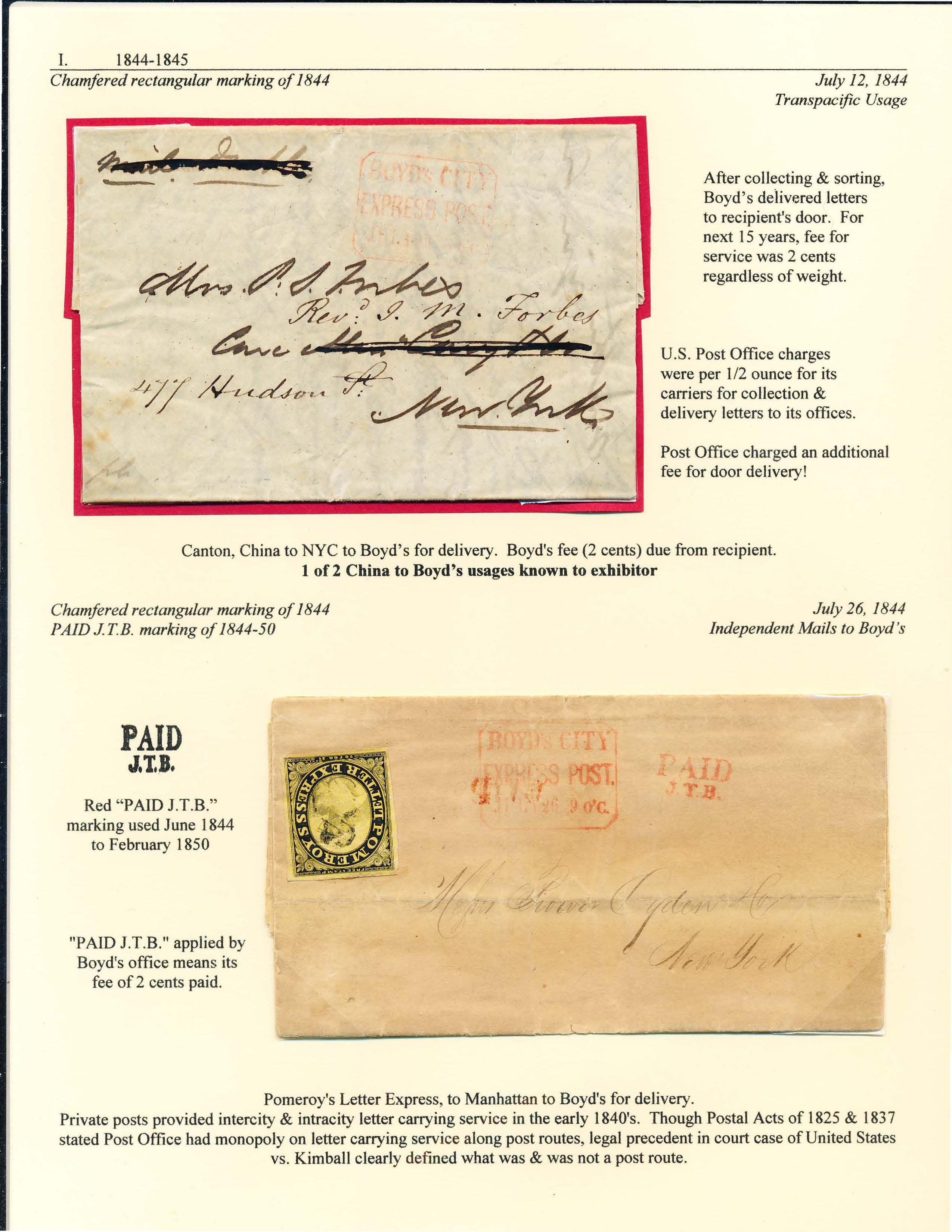
Boyd's, A Local Post: 1844-1889
By: Lawrence LeBel (2010)
Boyd's City Express Post, later known as Boyd's City Dispatch and finally as Boyd's Dispatch was arguably the most important and successful of the U.S. local posts! Their longtime success proved private enterprise served Manhattan's mail patrons better. Significant Earliest Known Usage (EKU) and Latest Known Usage (LKU) research and discoveries of Boyd's postal markings and adhesive usages are found throughout the exhibit. EKU and LKU information for Boyd's markings and postal emissions are based on Abt's article, Boyd's City Express Post as noted in the bibliography. The purpose of this cover exhibit is to show the viewer that the U.S. Post Office did not always have a monopoly on letter or mail handling services.
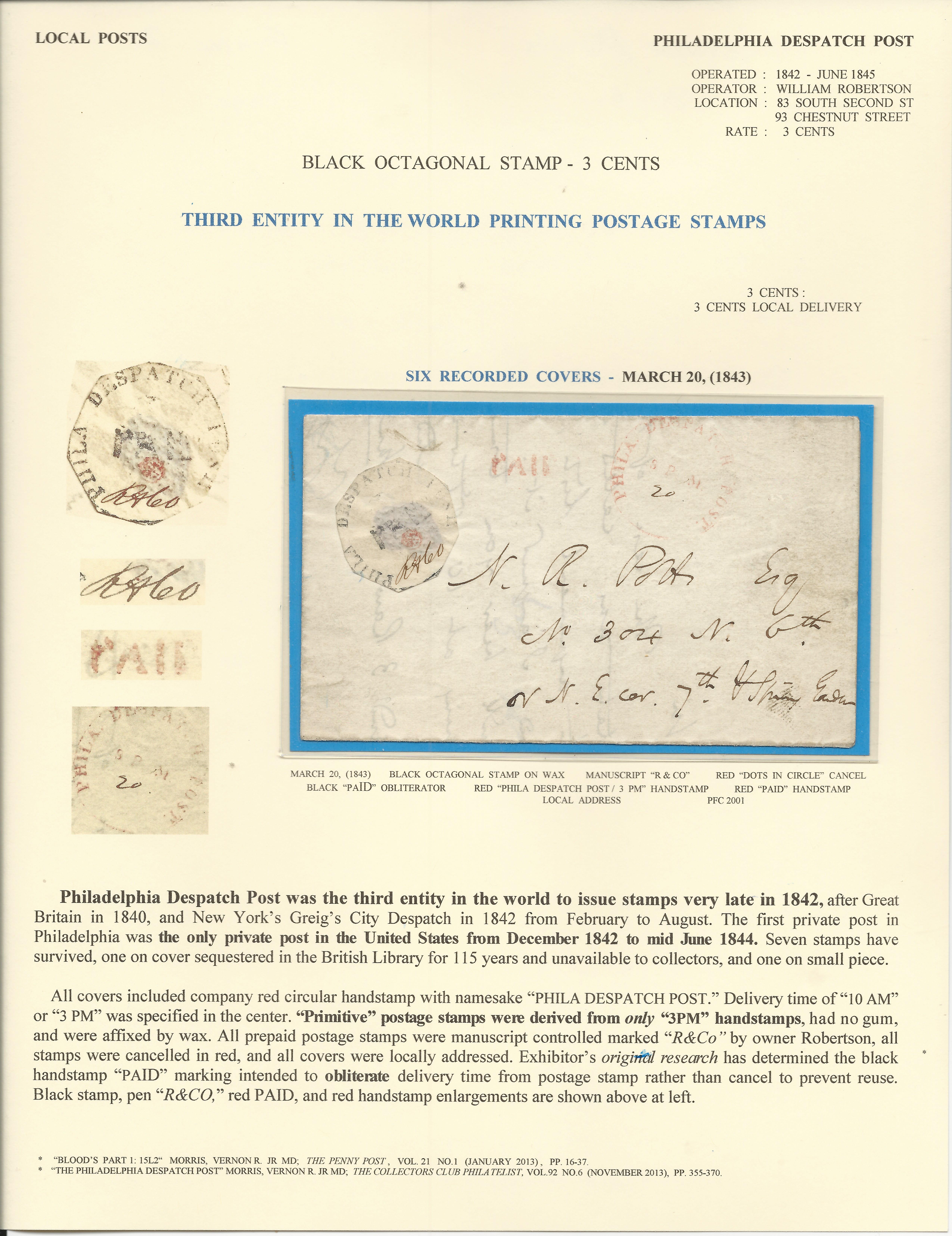
Fighting the Fed in Philadelphia
Part 1: Frame 1-4 | Part 2: Frames 5-8
By: Dr. Vernon Morris (2006)
During the mid 19th century Philadelphia was the second most populous city in the United States, fourth in the Western World. This postal history exhibit reveals the competitive struggle between private and government mail delivery. Postal rates were reduced by approximately two thirds and service greatly improved. Philadelphia is unmatched by any city in the world for it's diverse, colorful, and rich legacy during the formative years of philately.
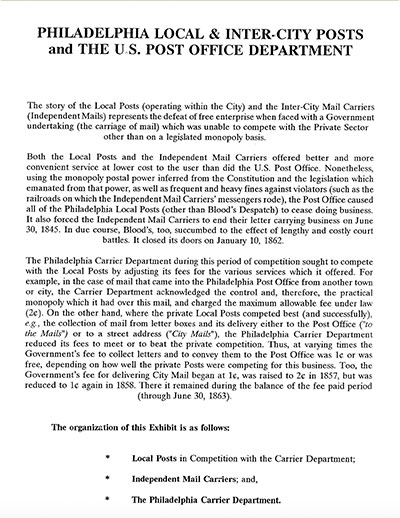
Philadelphia Local and Inter-City Posts and the U.S. Post Office Department
By: Steven M. Roth (2023)
The exhibit tells the story of the local posts that operated letter collection and delivery businesses in the city of Philadelphia, primarily during the 1840s and 1850s. It also includes the postal history of Philadelphia's intra-city letter carriers as well as the independent mail companies that competed with the post office for eighteen months from January 1844 to July 30, 1845.
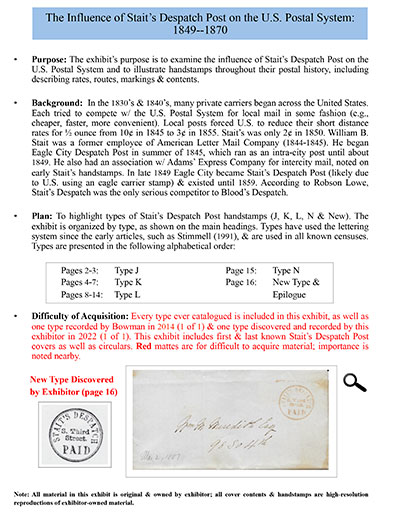
The Influence of Stait’s Despatch Post on the U.S. Postal System: 1849-1870
By: Richard Lomax
The exhibit’s purpose is to examine the influence of Stait’s Despatch Post on the U.S. Postal System and to illustrate handstamps throughout their postal history, including describing rates, routes, markings and contents.
Fakes and Fantasies
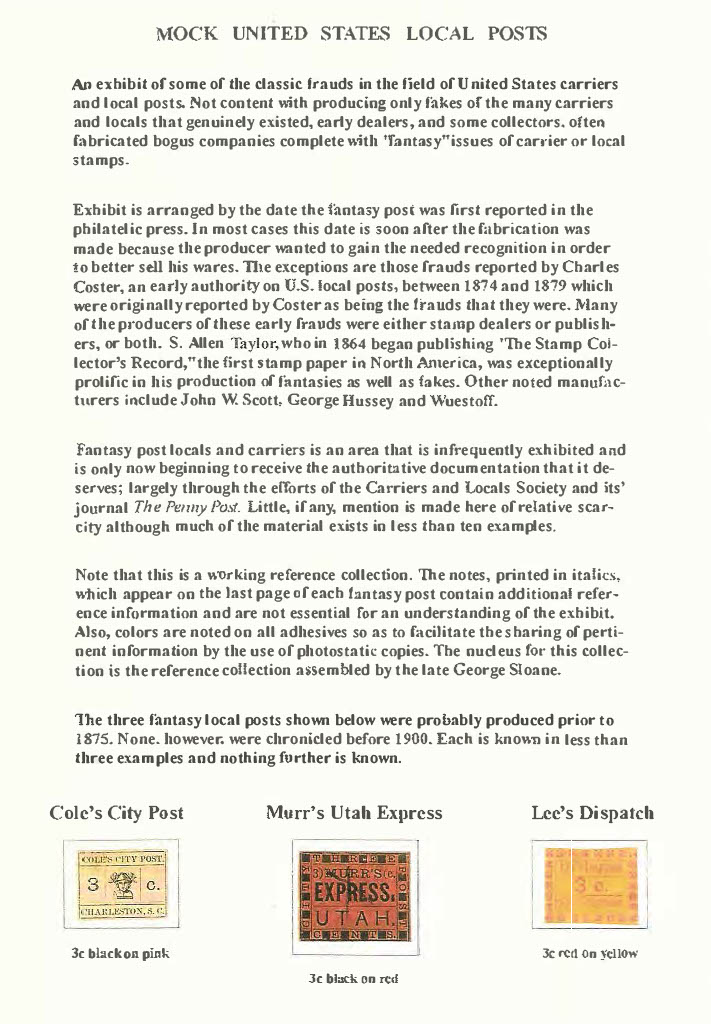
Mock United States Local Posts
By: Richard Frajola
Mr. Frajola’s exhibit is a reference collection that displays some of the classic fakes and fantasies in the field of U.S. carriers and local posts. The exhibit describes the major identifying characteristics of the fakes and fantasies included in the exhibit and identifies the dealers and collectors who created them. Many of the examples are scarce and exist in less than ten examples.


